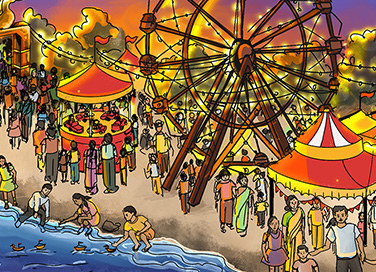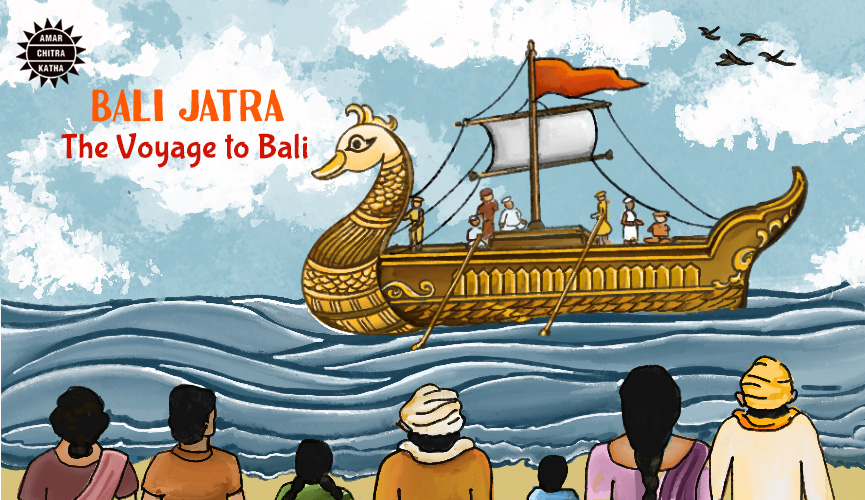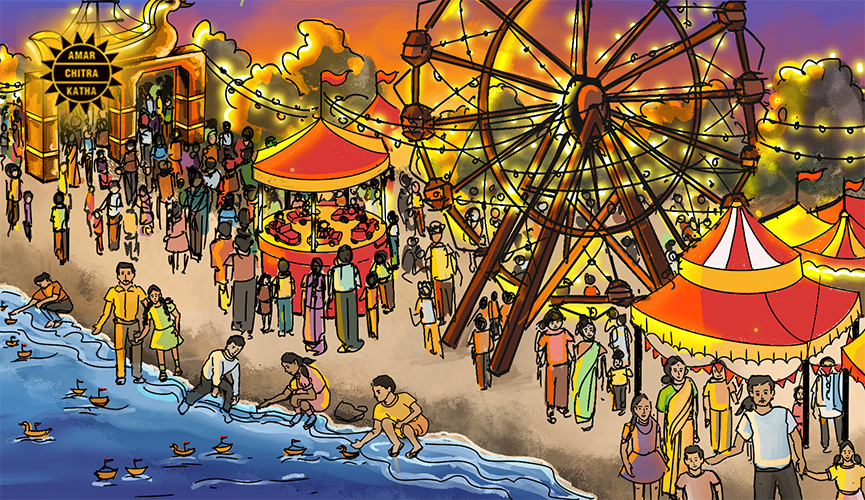Bali Jatra: The Voyage to Bali
- February 14, 2024


Bali Jatra: The Voyage to Bali
- February 14, 2024
By Jayshree Misra Tripathi
In the month of Karthika of the Hindu Lunar Calendar, that falls mid-October to mid-November, the night of the full moon is called Karthika Purnima. A festival is celebrated in Odisha to honour ancient mariners and traders, called Sadhabas. On this night, they would set sail for the distant shores of Bali, in present- day Indonesia.

Early before dawn on this day, the 15th day of Shukla Paksha (waxing moon), people assemble on the banks of the River Mahanadi in Cuttack, or at nearby rivers and ponds, to sail replicas of the ancient large boats, called Boita. Inside each boat is a lit clay diya, some betel nuts and flowers. These boats were, once upon a time, made of banana peels but nowadays, even other materials are used. These miniature boats are colourfully decorated. As the boats are gently lowered into the waves that lap the shoreline, the women and children chant, “Aa Ka Ma Bai, Pana Gua Thoi.” These chants are mentioned in Sarala Dasa’s version of the Mahabharata, written in the 15th century AD.
To receive more such stories in your Inbox & WhatsApp, Please share your Email and Mobile number.
Then prayers are offered in the Boita Bandana ceremony.
The acronyms* Aa, Ka, Ma, Bai, denote the seasons that the ships set sail and left our shores, in different directions, according to the monsoon winds and ocean currents. The weather and wind-flow have been studied in India since the second century BCE.
The mariners had special instruments that, together with astronomical calculations of the stars, helped them to navigate their ships. It is said the ships carried tamed birds on board, called Disa Kaka or Direction Birds. These birds helped in mapping directions on land.
The Chinese traveller and monk Yijing (AD 635-713) noted that it took thirty days to sail from the ancient port of Tamarlipti in Kalinga (Odisha), now in West Bengal, to the Andaman and Nicobar Islands. From there with the help of ocean currents, it took just twenty days to reach China! The Tang dynasty has records of a Bhaumakara prince, Subhakara Deva, who brought many Buddhist Mahayana Tantric scrolls and texts to the Tang Dynasty Court in AD 790.
Bali Jatra, or the voyage to Bali, was not a direct route for the ancient mariners. They set sail from the banks of the River Mahanadi in Cuttack, in mid-November, with the help of the north-eastern monsoon winds, down the coastline to dock in Sri Lanka, then known as Lankadeepa. There they would trade supplies, that included ivory, precious gems, horses, glass and perfumes. On their return journey, they would take back elephants and pearls. They would stock up on fresh water and coconuts before they set sail again, guided by ocean currents across the Indian Ocean. Now they were northward bound, towards Swarnadipa, the Island of Gold, as mentioned in Sanskrit texts. This is the northern sector of Sumatra. There are accounts of the mariners either setting sail towards Borneo and Vietnam, or to Bali and Java, then called Yavadwipa or the Island of Grain.
It is interesting to note how the mariners decided on the duration at a port-of-call. Leaving Odisha in mid-November, the journey to Bali would have taken at least three months. In order to harness the early South-West monsoon winds for the return journey, they would have to cast-off from Bali by mid-March. This would ensure they reached home in May.
The merchants dealt mainly with cotton textiles that were very popular at their ports of call. For instance, the Sambalpuri ikat textile weaving is also found in Bali today, called Patola, woven in themes from India mythology. Trade flowed both ways and our merchants, would purchase Chinese silks in Vietnam and camphor in Sumatra. Spices were exchanged too, which included peppercorns and cloves, even betel or areca nuts. Cowry shells were also used as exchange.
Trade links also, but naturally, led to cultural exchanges in arts and crafts and spiritual experiences. Hinduism still exists in parts of Bali. Buddhism is followed in many countries in Southeast Asia. The skill of the Kalinga mariners over sea-routes has been cited as “The Lord of the Sea” by Kalidasa in his Raghuvamsa. Words from the various languages were often absorbed into the native languages. Bou in Odia is mother as in Balinese too! There is also a great similarity in the masks found in Odisha and Sri Lanka and Bali. The Ramayana is depicted through dances, shadow puppetry and many other forms too

Nowadays, at the Bali Jatra Fair in Cuttack, there are giant wheels, traditional puppet shows, food, dance and song. It is also a tradition to stage a play on the legend of Tapoi – the only beloved daughter of a rich businessman, who had seven sons. When he became a widower, he would sail to Bali each year on Karthika Purnima, with some of his adult sons. One year he took all his seven sons with him, thinking his daughters-in-law would care for his youngest child, his only daughter, Tapoi. Sadly, the sisters-in-law made her clean the home and cowshed, wash their clothes, even bring wood from the forest. They often hit her and left her hungry. Tapoi would cry all alone and pray to Mangala Devi, a form of Durga, to end her misery. Months passed.
One day, she mustered enough courage to run away deep into the nearby forest while gathering wood. Her father and brothers returned from their voyages earlier than expected and were furious. They went in search of her and found her, crying piteously. The malicious daughters-in-law of the merchant were punished for their cruelty.
This legend also makes us ponder upon the impact that long, hazardous journeys had on the families left behind. Would they remain safe? Would they have enough to eat?
Our ancient mariners and merchants defied all odds to bring home goods and riches, for the prosperity of their families. Kalinga’s flourishing trade links are impressive even today – the sea-voyages to Sri Lanka, Java, Borneo, Sumatra, Myanmar (Burma) and Bali. Similar festivals are held even in these parts of the world, such as Masakapan Ke Tukad of Bali, the Loi Krathong of Thailand, the Bon Om Touk of Cambodia, and the That Luang of Laos – all held around the same time of the year.
Read about more such interesting tales from history, only on the ACK Comics app!
To receive more such stories in your Inbox & WhatsApp, Please share your Email and Mobile number.

Comic of The Month
Dr Kotnis in China
In 1938, twenty-eight-year-old Dr Dwarkanath Kotnis was part of a medical mission that India sent to aid China in its war with Japan. Dr Kotnis was committed to saving lives, even in the precarious war-time situation. He remained behind to continue his work in China after the rest of his group returned. He was, and remains, a selfless and fearless hero to the people of China and India alike.